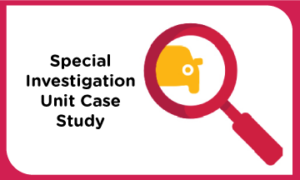Insurance fraud can be classified in two categories: hard fraud and soft fraud. Hard fraud involves deliberately causing damage to collect on an insurance policy. Soft fraud is more common and includes exaggeration of the severity or extent of damages to the claimant or vehicle to increase the insurance payment. Soft fraud also includes misrepresentation or intentional omission of information to obtain a lower insurance premium.
Recent technological advancements have also provided a new ally in fraud prevention – the vehicle itself. Systems in the car provide key analytics and data to support or refute what was said to have occurred during a crash.
Maryland Auto takes the prevention of insurance fraud seriously by implementing measures to flag suspicious claims through technology and through ongoing training of all claims professionals to better identify the signs of fraud. If a claim presents fraud indicators, it is sent to our Special Investigations Unit (SIU) for further investigation.
This claim began when the Maryland Auto policyholder filed a claim stating that their vehicle was involved in a hit-and-run accident. The policyholder stated that while driving a friend home in an unfamiliar area, they pulled over to enter the friend’s address into their GPS. They claimed to have been struck while stopped, by another vehicle that fled the scene. Both the policyholder and their passenger claimed injuries. The policyholder claimed to have called the police after the incident but says that they did not respond.
However, the investigation revealed a different story.
In reviewing the damage, the driver’s side fender was pushed in without damage to the wheel or tire. In addition, the driver’s side curtain airbag was deployed and the left side of the hood, headlight, and bumper cover were also damaged. These damages are not consistent with the events that the policyholder reported.
Prior policies covering this vehicle and policyholder showed addresses in Baltimore, even though the policyholder’s current address differed. It was also discovered that the policyholder’s passenger lived less than a mile away from the loss location, raising questions as to why the policyholder would have needed to pull over to enter the address into a GPS.
The SIU Investigator conducted a comprehensive investigation, including an Event Data Recorder (EDR) imaging report. The investigator was able to plug into the onboard computer and review critical information, such as the vehicle’s speed and braking, similar to the black box on an airplane. This report revealed crucial information – there was not one, but two separate impacts, with only seconds in between. And the vehicle was not stopped during either event. The insured vehicle was traveling at 11 miles per hour at the time of the first incident, with the speed increasing to 19 miles per hour at the time of the second impact. Notably, the brakes were never applied between the impacts. The data from the second crash showed both front seatbelt pretensioners deployed as well as the side curtain airbags. Seat belt pretensioners secure the occupant safely to their seat by tightening their seat belt.




